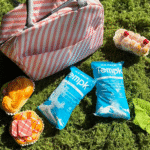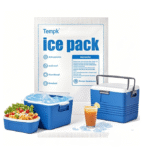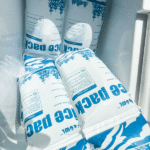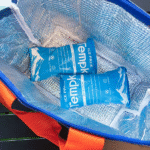Shipping temperature-sensitive goods requires an effective and reliable cooling method to ensure items stay fresh and safe. Foil-lined dry ice bags are a key solution for businesses shipping perishable products like pharmaceuticals, Essen, und biologische Materialien. This guide will explore the functionality, Vorteile, Best Practices, and the latest trends in using foil-lined dry ice bags to maintain temperature control during transit.
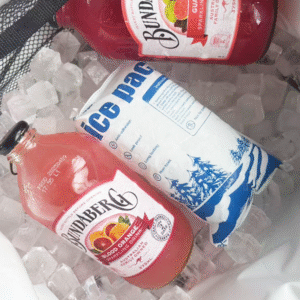
What Are Foil Lined Dry Ice Bags?
Foil lined dry ice bags are specialized packaging designed to keep temperature-sensitive items cold during transport. These bags are constructed with multiple layers of materials, with the inner layer typically made of a reflective foil to block radiant heat. This foil is combined with insulating materials like foam to protect items from external temperature fluctuations and to slow down the sublimation of dry ice.
Key Benefits of Using Foil Lined Dry Ice Bags
Verbesserte Isolierung: The reflective foil acts as a barrier that reflects up to 97% von strahlender Hitze. This significantly reduces heat transfer, keeping your products at ultra-low temperatures for a longer period.
Durability and Strength: Foil-lined dry ice bags are designed to withstand the demands of shipping, including rough handling and long transit times. Their construction ensures your products are not only insulated but also protected from physical damage.
Cost-Effective and Lightweight: Despite offering superior insulation, these bags are lightweight and cost-effective to ship. This helps save on overall transportation expenses.
Leak-Proof and Ventilation: The bags are designed to prevent leakage of carbon dioxide gas while also allowing for controlled venting. This is crucial since dry ice sublimates and releases CO₂ gas that needs to escape safely without causing pressure buildup inside the bag.
How Do Foil Lined Dry Ice Bags Work?
The functionality of foil lined dry ice bags relies on their ability to minimize heat transfer through three main mechanisms: Strahlung, Leitung, und Konvektion. The reflective foil layer blocks radiant heat, while the foam or bubble core inside the bag slows down both conduction and convection heat transfer. This combination creates a highly efficient cooling system that can maintain a cold temperature for extended periods.
In addition to reducing heat transfer, foil-lined bags also help in regulating the sublimation rate of dry ice. This ensures that dry ice lasts longer and minimizes waste, making them a practical choice for long-distance shipping.
Best Practices for Using Foil Lined Dry Ice Bags
To ensure the maximum effectiveness of foil-lined dry ice bags, Folgen Sie diesen Best Practices:
1. Correct Bag Size and Dry Ice Quantity
-
Choose the right bag size: Ensure the bag fits your shipment snugly to avoid excessive dry ice usage. A perfectly fitted bag maximizes insulation efficiency and reduces waste.
-
Calculate the correct amount of dry ice: Typischerweise, 5–10 pounds of dry ice per day of transit will keep products cold for up to 24 Std.. Adjust based on the ambient temperature and specific needs of your shipment.
2. Proper Packaging Techniques
-
Schichtung: Place dry ice at the bottom of the bag, with the temperature-sensitive items placed on top. This allows for optimal cooling.
-
Belüftung: Make sure the bag allows for proper venting of CO₂ gas to prevent pressure buildup. This is essential for safety and effective cooling.
3. Einhaltung der Vorschriften
-
Labeling and Documentation: Ensure that the outer packaging is properly labeled with “Trockeneis” oder “Kohlendioxid, Solide,” along with the net weight of the dry ice (Und 1845).
-
Carrier Requirements: Different carriers may have specific rules for shipping dry ice. Always confirm the requirements for your chosen carrier, especially for air and international shipments.
2025 Trends in Foil Lined Dry Ice Bag Technology
Während sich die Kaltkettenindustrie weiterentwickelt, foil-lined dry ice bags are benefiting from several technological advancements:
1. Intelligente Verpackungen
Smart packaging solutions are gaining traction, with temperature sensors and real-time tracking becoming integrated into foil-lined dry ice bags. These innovations allow for remote monitoring, providing you with live data on your shipment’s temperature during transit. This ensures that any temperature deviations can be quickly addressed.
2. Sustainability and Biodegradable Materials
With increasing environmental concerns, manufacturers are beginning to use biodegradable and recyclable materials for the production of foil-lined dry ice bags. These materials offer excellent insulation properties while reducing the environmental impact of packaging.
3. Hybridkühlungslösungen
Combining Phase Change Materials (PCMs) with dry ice is becoming more common. PCMs absorb and release heat at specific temperatures, which can help extend the hold time of dry ice shipments while reducing the amount of dry ice needed.
Foil Lined Dry Ice Bags vs. Other Packaging Options
When comparing foil-lined dry ice bags to other packaging options, such as gel packs or Styrofoam containers, foil-lined bags offer distinct advantages for long-duration shipments requiring deep freezing. Below is a comparison table:
| Besonderheit | Folie mit Trockeneisbeutel mit Folien gefüttert | Gelpackungen | Styrofoam Containers |
|---|---|---|---|
| Temperaturbereich | Unter -78,5 ° C. (Trockeneis) | 32° F bis 50 ° F. (Gekühlt) | 32° F bis 50 ° F. |
| Haltbarkeit | Hoch, pünktlich-resistent | Mäßig | Hoch, isoliert |
| Versanddauer | Long-lasting cooling for days | Shorter cooling duration | Moderate cooling duration |
| Kosten | More expensive | More affordable for short trips | Mid-range price |
Foil-lined dry ice bags are the ideal choice for shipments that need to maintain a deep freeze (-78.5° C oder unten). Jedoch, if you’re shipping products that require refrigeration (32° F bis 50 ° F.), options like gel packs or Styrofoam containers may suffice and could be more cost-effective for shorter durations.
FAQs
Q1: How long will dry ice last in a foil lined bag?
A1: The duration of dry ice’s effectiveness depends on the insulation, Umgebungstemperatur, and the amount of dry ice used. Under optimal conditions, foil-lined bags with sufficient dry ice can keep items cold for up to 24–96 hours.
Q2: Are foil lined dry ice bags suitable for food shipments?
A2: Ja, foil lined dry ice bags are perfect for shipping frozen food products. They ensure that the temperature stays within the required range, maintaining the quality of perishable food items during transit.
Q3: What regulations should I be aware of when shipping with dry ice?
A3: Shipping dry ice requires compliance with labeling, Verpackung, and documentation standards set by regulatory bodies such as IATA and UPS. Always ensure your shipment meets these requirements to avoid delays.
Abschluss
Foil-lined dry ice bags are an essential tool in the cold chain shipping industry, offering superior insulation and ensuring the safe transport of temperature-sensitive goods. By understanding their features, following best practices, and staying informed about industry trends and regulations, you can optimize your shipping processes for efficiency and compliance in 2025.
Über Tempk
Tempk is a leading provider of cold chain packaging solutions. Our foil-lined dry ice bags are designed with the latest technology to ensure optimal insulation and durability for shipping perishable items. Contact us today to learn more about our innovative solutions.
















